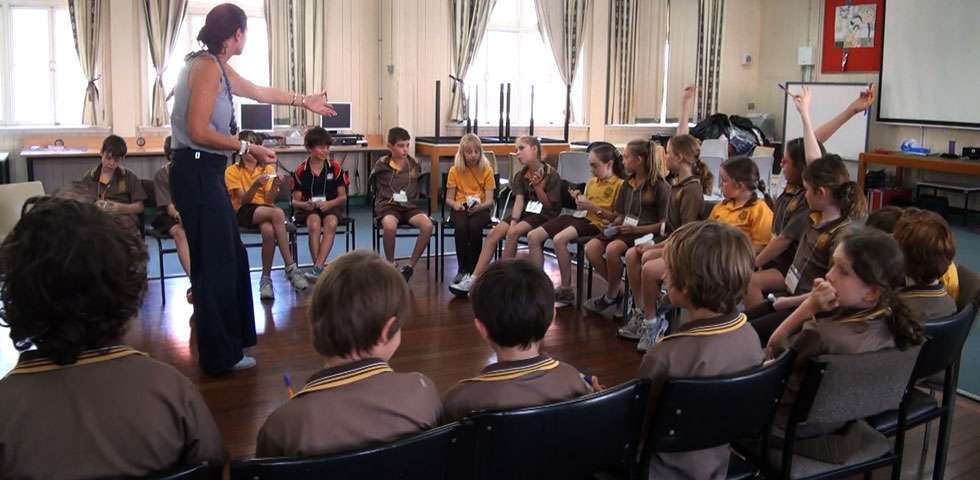
Drama
PLANNING
Since drama's subject matter is centred on human behaviour, and besides learning the art form, knowledge and skills to express human behaviour, drama planning can begin from a number of different • Drama content or skills to be learned • Content in another subject area entirely • An inviting pre-text • An idea from the students themselves • An idea or stimulus from current news, or what is happening in the community .
This drama started with the teacher's aim: to give the students practice in oracy skills, specifically practice in all of the Part of the aim of this drama was to ensure that the five functions language, namely informing, controlling, negotiating, feeling and imagining were all actively practised and the students' talking and active listening were maximised. and a range of Every social situation has its own appropriate and effective language, known as its register, which includes the degree of formality, the forms of address, the appropriate status levels for initiating and responding and the vocabulary that is appropriate. In this drama, the students were challenged to use complex registers of formal address and demonstrate respect through the appropriate vocabulary and non-verbal language., both public and private.
The teacher used as a This is a stimulus of any kind that raises interesting questions that can be turned into drama. the recent discovery of a vast treasure in an Indian temple. This provided opportunities for learning about Asia and Australia's Engagement with Asia; cultural understanding (India's history and contemporary challenges); and In any subject dealing with other cultures, care and respect must be shown. In drama, where we step into the shoes of others, our fictional world needs to be as authentic as possible. However, that does not mean we should experience what drama educator and theatre director Wesley Enoch calls 'the paralysis of integrity', where we avoid any forays into others’ cultural territory because we are too fearful of causing offence. This drama work has been checked retrospectively and fully approved by a Hindu priest.. All of these competencies could be incorporated within a This is drama with no outside audience, where the participants use a range of types of role-play that are mixed with theatre techniques to explore a dramatic situation or a story by enacting it. The central method is usually experiential role-play, where the participants together identify and empathise with the characters and act out their roles in the story. where the drama content would be learned by students from sustaining multiple roles, namely managing tension, using a wide range of language (making and presenting) and reflecting on their work within and outside the drama (responding). This led to the The question that the drama sets out to answer. 'Who has the right to the treasure of Trivandrum, and what should it be spent on?' The drama would move from canvassing ideas and plans for using the treasure, to an examination of child labour in India and the possibility of persuading a key authority (embodied as the ancient and revered Maharajah) to use the money to improve child poverty. Process drama can only work if all the students are actively engaged and involved. Fortunately, this particular pre-text already provided The teacher’s aim and focus questions (the 'play for the teacher') have to be centred on finding a dramatic situation that is familiar and exciting enough to 'hook' the children’s initial interest (the 'play for the children'). In this drama, the pre-text of a mystery surrounding discovered treasure provided an immediate and effective hook. of investigating a mystery involving discovered treasure. This unit would begin with a treasure hunt around the classroom where students would piece together clues about the treasure of Trivandrum.
The roles were based on a simple form of the This technique is central to process drama and involves the students taking roles that demand real expertise (e.g. scientists, explorers, or in this drama, top investigative reporters), and in order to respond to the challenge in the drama, they have to acquire and use at least the rudiments of that expertise. and centred on an Indian TV studio with experienced reporters (the children’s main roles, with the As the teacher, you can and should take part in the drama yourself. Doing so will:
• help the students to take the drama seriously • give you the chance to help control what happens without stopping the drama • give you an unparalleled opportunity to suspend the power and status relationships in the classroom. See supporting document: Guide to Teacher-in-role as their producer). Students in their roles would investigate the treasure, what people thought of it and what should happen to it. Both the students and the teacher would change roles where necessary to play people affected by the treasure, townspeople and victims of child labour practices. These would be interspersed by more formal drama sessions that involved the students working as actors and dancers to help them visualise and embody the scenes and the ceremonials.
The planning of the whole unit provided the In process drama some planning changes are inevitable if the tension drops or good ideas emerge. In this drama, adding a previously unplanned physical activity in Lesson 3 allows the students to realise child labour more personally and vividly. for possible changes, as is necessary in process drama.

The teacher-in-role fine tunes her planning on her feet.